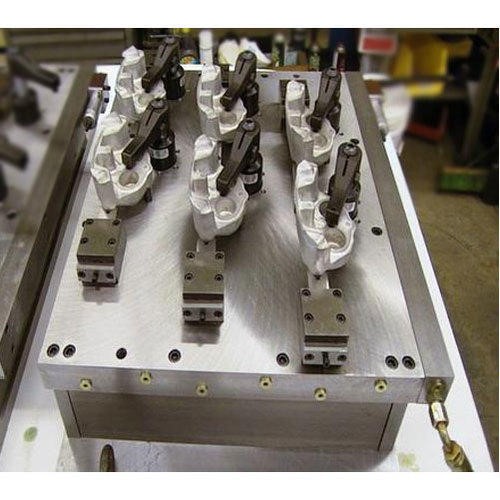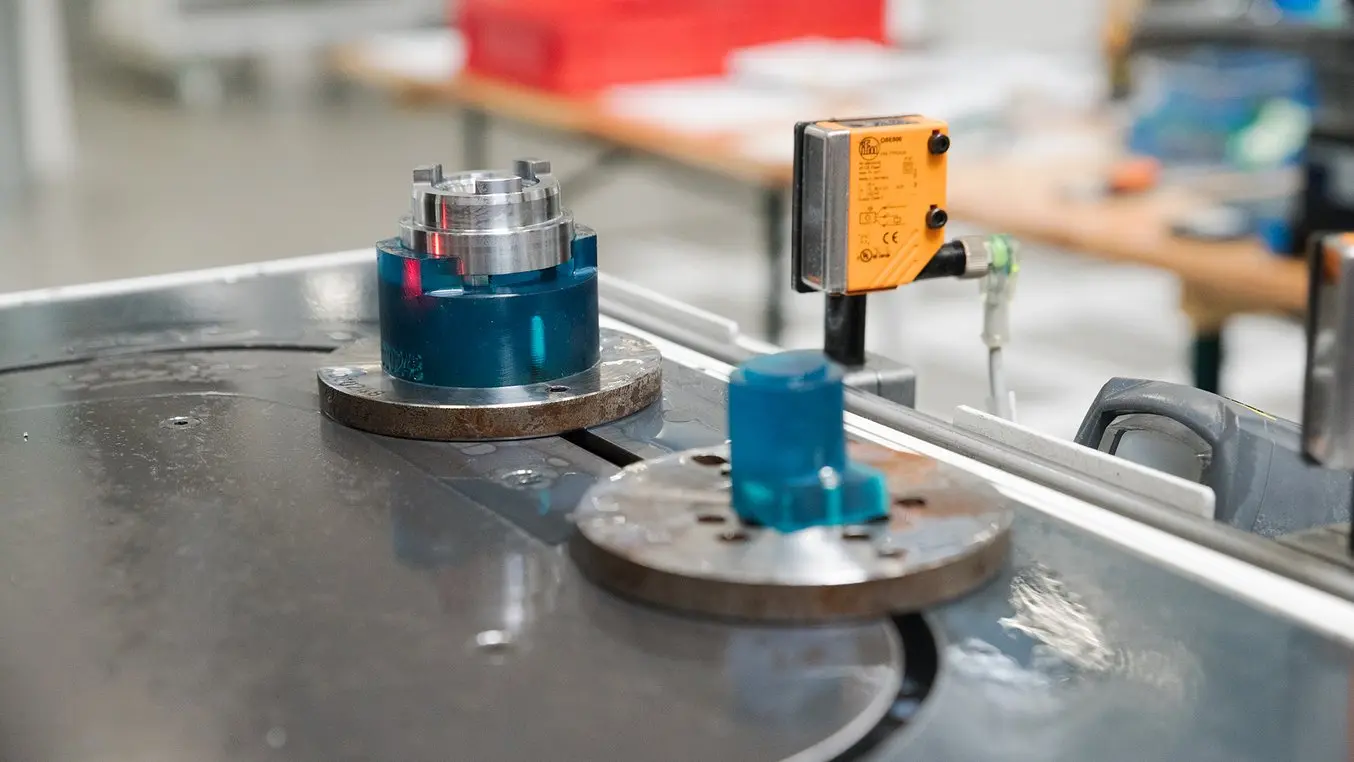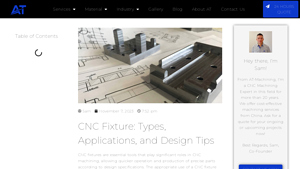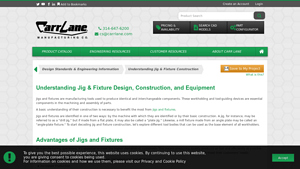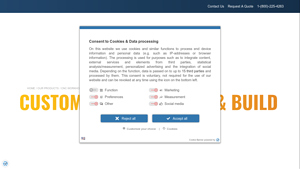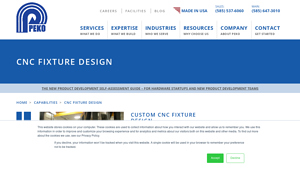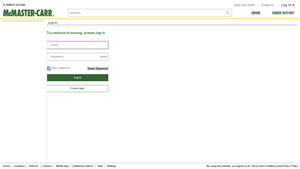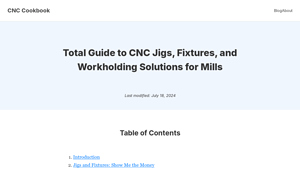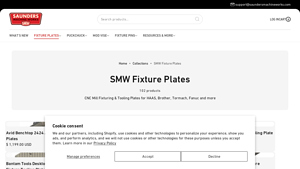Machining Fixtures Guide: Type, Cost, Top List…
Introduction: Navigating the Global Market for machining fixtures
The global market for machining fixtures presents a complex landscape where international B2B buyers grapple with sourcing reliable and efficient solutions. With increasing competition and rising demands for precision engineering, organizations in regions such as Africa, South America, the Middle East, and Europe—particularly in nations like Saudi Arabia and Nigeria—face the critical challenge of ensuring that their machining processes are both effective and cost-efficient. A well-chosen machining fixture can significantly enhance productivity by providing stable workholding, minimizing errors, and ensuring high repeatability in production runs.
This comprehensive guide to machining fixtures delves into the various types available in the market, including milling, turning, and drilling fixtures, while also examining their diverse applications across multiple industries. Readers will gain insights into essential design considerations and the process of vetting suppliers to ensure quality and compliance with international standards. We will also analyze cost factors and budget alignment, empowering buyers to make informed purchasing decisions that best suit their operational needs. By navigating through this guide, B2B buyers will be equipped to procure the right machining fixtures, optimizing their manufacturing capabilities while staying ahead in a dynamic global environment.
Understanding machining fixtures Types and Variations
| Type Name | Key Distinguishing Features | Primary B2B Applications | Brief Pros & Cons for Buyers |
|---|---|---|---|
| Milling Fixtures | Designed specifically for CNC milling operations; may include rotary tables and vise fixtures. | Automotive components, aerospace parts, general machining. | Pros: High versatility, essential for precision parts. Cons: Requires careful design and setup for optimal performance. |
| Turning Fixtures | Used in lathe operations; typically involve chucks and faceplates for securing cylindrical workpieces. | Shaft manufacturing, automotive axles, piping components. | Pros: Efficient for rotational components, enhances processing speed. Cons: Limited to cylindrical parts and may require multiple setups. |
| Grinding Fixtures | Focused on holding workpieces securely during grinding; includes magnetic chucks and sine bars for precise alignment. | Tool sharpening, surface finishing, precision parts fabrication. | Pros: Improves surface finish and size accuracy. Cons: Can be costly, requires skilled handling to prevent damage. |
| Drilling Fixtures | Specialized for drilling operations; facilitate accuracy and repeatability through templates and guides. | Electronics housing, mechanical assemblies, component integration. | Pros: Increased accuracy, saves time through repetitive tasks. Cons: Limited flexibility, often requires customization for specific parts. |
| Boring Fixtures | Used for enlarging pre-drilled holes with high accuracy; includes boring bars and heads that position bore tools correctly. | Engine block machining, pump components, precise hole enlargements. | Pros: High precision for critical applications, enhances tool life. Cons: May require a skilled operator for setup and adjustments. |
What Should Buyers Know About Milling Fixtures?
Milling fixtures are designed to secure workpieces in place during CNC milling operations. Their structure can vary, incorporating elements like rotary tables and vise fixtures to accommodate different shapes and sizes. These fixtures are essential for producing precision parts in industries such as automotive and aerospace, where the margin for error is minimal. When considering a milling fixture, buyers should assess the flexibility of the design, the ease of setup, and how it integrates with existing equipment to ensure efficiency.
How Do Turning Fixtures Enhance Production?
Turning fixtures are specifically aimed at improving operations on lathes. They secure cylindrical workpieces through devices like chucks and faceplates, which facilitate efficient material removal along a singular axis. Commonly applied in the manufacturing of shafts and automotive components, these fixtures boost processing speed and repeatability. Buyers must consider the compatibility of the fixture with their lathe systems and evaluate the necessity for varied setups based on product requirements.
Why Are Grinding Fixtures Essential for Accuracy?
Grinding fixtures play a pivotal role in achieving high surface finish and dimensional accuracy in machined parts. Utilizing tools like magnetic chucks and sine bars, these fixtures hold the workpieces securely while grinding. They find paramount applications in tool sharpening and precision fabrication. Buyers should take into account the level of precision required for their specific operations and the potential impacts on product quality when investing in grinding fixtures.
What Advantages Do Drilling Fixtures Offer?
Drilling fixtures ensure precise alignment during drilling processes, significantly enhancing the consistency of hole placement across numerous parts. They often employ guides and templates that facilitate rapid production cycles in sectors such as electronics and mechanical assemblies. Buyers should evaluate the need for customization based on the complexity of parts being drilled and weigh the benefits of precision against the limitations of fixed setups.
How Do Boring Fixtures Contribute to Precision Machining?
Boring fixtures are crucial for applications requiring the enlargement of existing holes to tight tolerances. With tools like boring bars and heads that ensure correct positioning, they are integral in high-stakes manufacturing environments such as engine block machining. Buyers should consider the precision needs of their projects and the skill level required for effective use, balancing cost against the quality enhancements these fixtures can offer.
Key Industrial Applications of machining fixtures
| Industry/Sector | Specific Application of Machining Fixtures | Value/Benefit for the Business | Key Sourcing Considerations for this Application |
|---|---|---|---|
| Automotive | Assembly line fixtures for vehicle components | Enhances precision during assembly, leading to improved safety and reduced rework costs. | Understanding of automotive standards, ability to customize fixtures for different vehicle models. |
| Aerospace | Machining fixtures for turbine manufacturing | Increases productivity and consistency, ensuring parts meet stringent quality approvals. | Compliance with aerospace regulations and the ability to handle materials like titanium and composites. |
| Electronics | Fixtures for PCB assembly and testing | Improves efficiency in high-volume production and testing accuracy, reducing defects. | Compatibility with various PCB sizes and integration with automated handling systems. |
| Heavy Machinery | Machining fixtures for large component fabrication | Ensures stability and safety during machining of complex shapes, enhancing production timelines. | Ability to accommodate large parts and heavy loads, as well as the durability of fixture materials. |
| Oil & Gas | Custom fixtures for drilling applications | Provides reliability and accuracy in harsh environments, minimizing costly downtime. | Expertise in designing fixtures that withstand extreme conditions and can integrate with existing systems. |
How are Machining Fixtures Used in the Automotive Industry?
In the automotive sector, machining fixtures are integral to the assembly line process, specifically for vehicle components such as frames and engine parts. These fixtures secure parts in precise positions to ensure accurate welding and assembly, drastically reducing the likelihood of errors that could lead to safety issues or costly recalls. When sourcing fixtures for this industry, buyers should consider the necessary certifications and standards specific to automotive manufacturing, ensuring compliance with safety and quality regulations.
What Role Do Machining Fixtures Play in Aerospace Applications?
Machining fixtures are essential in aerospace manufacturing, especially for turbine and engine components. These fixtures guarantee that components are machined to exact specifications, meeting the strict quality criteria imposed by aviation authorities. Buyers in this sector should seek suppliers with experience in aerospace-grade materials and a proven track record in achieving compliance with airworthiness standards to ensure their fixtures can maintain operational integrity under stringent stress and environmental conditions.
How Are Machining Fixtures Implemented in Electronics Manufacturing?
In electronics manufacturing, particularly for printed circuit boards (PCBs), machining fixtures are used to automate and streamline the assembly and testing processes. These fixtures hold PCBs securely while soldering and testing, which enhances production rates and quality control. For international buyers, it’s crucial to work with suppliers who understand the need for flexibility in fixture design, allowing for rapid adaptation to different PCB sizes and configurations while also integrating seamlessly with automated systems to maximize throughput.
What Benefits Do Machining Fixtures Provide to the Heavy Machinery Sector?
The heavy machinery industry relies on machining fixtures to produce large, complex parts with high precision. These fixtures ensure parts do not shift during the machining process, thus prolonging the lifespan of both the fixture and the machinery. Sourcing considerations include the ability of fixtures to endure heavy loads and vibrations, and ensuring that the manufacturing materials can withstand the harsh operating conditions often found in this industry.
Why Are Custom Fixtures Crucial in the Oil & Gas Industry?
For the oil and gas sector, custom machining fixtures are vital for drilling components to ensure accuracy and safety in adverse environments. Such fixtures facilitate the secure positioning of parts for machining and testing, which is critical in minimizing downtime and improving operational efficiency. Buyers should prioritize suppliers that can design fixtures resistant to corrosive elements and capable of functioning effectively under extreme conditions, as well as those who can provide solutions for integrating with existing automated processes.
3 Common User Pain Points for ‘machining fixtures’ & Their Solutions
Scenario 1: Navigating the Complexity of Fixture Design for Diverse Operations
The Problem: Many international B2B buyers encounter significant challenges when attempting to design or select machining fixtures for varied manufacturing processes. Different machining operations such as milling, turning, or drilling each require specific fixture types and designs to ensure precision and efficiency. This complexity can lead to confusion, increased lead times, or even costly mistakes due to misalignment or inappropriate fixture use. Furthermore, buyers may lack the technical expertise to assess the compatibility of a fixture with their machinery, leading to reluctance in making decisions.
The Solution: To navigate the intricacies of fixture design, buyers should first conduct a thorough assessment of their manufacturing processes and workpieces. This involves collaborating with engineering teams to understand the particular requirements of each operation. Once requirements are clear, sourcing fixtures tailored to specific machining operations through reputable suppliers is crucial. Buyers can leverage advanced technologies such as CAD (Computer-Aided Design) software or simulation tools which allow them to visualize how different fixtures work in conjunction with their equipment. Additionally, consulting with experienced manufacturers during the fixture selection process can provide insights into the latest innovations or best practices.
Scenario 2: Minimizing Downtime Due to Fixture Setup Errors
The Problem: Fixture setup errors are a frequent source of downtime in machining environments, leading to production delays and increased costs. B2B buyers, especially those operating in industries where time is critical, may find that improper fixture alignment or clamping can result in defective parts. This not only delays production schedules but can also erode customer trust if deadlines are repeatedly missed, especially in competitive markets in regions like Africa and South America.
The Solution: To minimize downtime caused by setup errors, implementing standardized operating procedures (SOPs) for fixture installation can be highly beneficial. Training staff on best practices for fixture installation and verification techniques can dramatically reduce the likelihood of mistakes. Offering ongoing training sessions and workshops leads to better understanding and familiarity with fixture characteristics among the workforce. Furthermore, investing in fixtures with user-friendly adjustments or visual guides can help ensure accurate setup each time. Where possible, consider incorporating automation technology that can assist in the alignment and clamping process, such as robotic systems that use sensors to verify proper fixture positioning before machining begins.
Scenario 3: Managing Fixture Wear and Maintenance Costs
The Problem: Machining fixtures inevitably experience wear and tear over time, which can lead to inconsistencies in the quality of produced parts. This wear can also accumulate additional costs through the need for replacements or extensive maintenance. These factors are especially crucial for B2B buyers in industries where precision is paramount, such as aerospace or automotive manufacturing; inconsistencies can result in significant financial losses and complications in compliance with industry standards.
The Solution: To manage the wear and maintenance of machining fixtures effectively, adopting a proactive maintenance strategy is essential. This begins with regular inspections and applying best practices for cleaning and lubricating fixtures to prolong their lifespan. Establishing a dedicated maintenance schedule allows for assessing the condition of fixtures before they fail. Additionally, investing in quality fixtures made from durable materials, like hardened steel or advanced composites, can reduce the frequency of replacements. Implementing a “life cycle assessment” approach can help buyers evaluate total ownership costs, including maintenance and replacement versus initial acquisition expense. Partnering with fixture manufacturers who offer long-term warranties or repair services can also provide peace of mind and cost-saving opportunities in the long run.
Strategic Material Selection Guide for machining fixtures
What Are the Key Properties of Different Materials Used in Machining Fixtures?
When selecting materials for machining fixtures, it’s crucial to balance performance, cost, and local conditions. Here, we analyze four common materials: aluminum, steel, cast iron, and composite materials, emphasizing their applicability for international B2B buyers.
How Does Aluminum Perform as a Material for Machining Fixtures?
Aluminum is prized for its lightweight and corrosion-resistant properties. It boasts a high strength-to-weight ratio, making it ideal for fixtures that require high precision without added mass. Additionally, aluminum can withstand moderate temperatures and possesses good machinability.
Pros: Aluminium fixtures are lightweight, reducing the overall weight of assembled machinery. They are less likely to rust, which is an advantage in humid climates such as parts of Africa and South America. Moreover, they can be economically produced through extrusion.
Cons: However, aluminum has lower tensile strength than steel, making it less suitable for heavy-duty applications. Its higher cost compared to other metals may also deter some buyers, especially when budget constraints are significant.
Impact on Application: Aluminum is well-suited for applications requiring precision and medium stress levels, such as automotive and aerospace industries.
Considerations for International Buyers: Buyers should ensure compliance with international standards like ASTM or DIN for quality assurance. Given the rising interest in lightweight materials, understanding local availability and cost fluctuations in aluminum is crucial.
Is Steel a Better Alternative for Machining Fixtures?
Steel, including carbon and stainless steel, is known for its durability and resistance to wear and deformation. Steel fixtures can withstand high pressures and temperatures, making them suitable for heavy machining operations.
Pros: The primary advantage of steel fixtures is their strength, which allows them to hold up under extreme conditions. This material also provides excellent dimensional stability during machining processes, which is critical for precision manufacturing. Steel is widely available and adheres to a variety of international standards.
Cons: The primary drawback is corrosion susceptibility, particularly in uncoated steel, which could be an issue in humid regions. Additionally, heavier than aluminum, steel fixtures may increase overall machinery weight, leading to potential handling challenges.
Impact on Application: Steel fixtures are often used for heavy-duty machining applications like industrial manufacturing and construction machinery.
Considerations for International Buyers: Shipping logistics can vary significantly; thus, it’s essential to consider local supply chains for procuring steel compliance with applicable standards. For instance, stainless steel is preferred in industries with stringent corrosion requirements.
Can Cast Iron Be Used Effectively for Machining Fixtures?
Cast iron is known for its remarkable damping capacity and rigidity, making it ideal for setups that need to minimize vibrations during machining. This material performs well under compression and is less prone to distortion compared to other metals.
Pros: Cast iron’s ability to absorb vibrations ensures precise machining results, which is critical in high-accuracy operations. It also tends to be less costly than steel and aluminum for certain applications.
Cons: However, cast iron is brittle; correct handling and installation are crucial to avoid cracking. Its weight can complicate transport and assembly, especially in regions with less robust logistics.
Impact on Application: Cast iron is frequently used in manufacturing settings that rely on stability, such as automotive and general machine tool applications.
Considerations for International Buyers: Due to its weight and handling requirements, buyers should coordinate shipping and local transportation effectively. Given the material’s demand for compliance, ensuring adherence to relevant standards is critical.
How Do Composites Change the Game for Machining Fixtures?
Composite materials, which combine various elements such as fibers and resins, have gained popularity in machining fixtures due to their unique properties like lightweight and high strength.
Pros: Composites can be engineered for specific properties, including enhanced corrosion resistance and thermal stability. Their lightweight nature simplifies assembly and transport, making them compatible with fast-paced manufacturing environments.
Cons: The primary challenge is their often higher costs and the need for specialized manufacturing techniques, which can deter investment. Additionally, durability under extreme conditions may be less than that of metals.
Impact on Application: Their versatility makes composites suitable for aerospace applications where weight reduction is critical without compromising integrity.
Considerations for International Buyers: Knowledge of local regulations around composite materials is vital, as different regions may have varying compliance requirements.
Summary Table of Material Considerations
| Material | Typical Use Case for Machining Fixtures | Key Advantage | Key Disadvantage/Limitation | Relative Cost (Low/Med/High) |
|---|---|---|---|---|
| Aluminum | Aerospace, automotive precision fixtures | Lightweight and corrosion-resistant | Lower tensile strength | Medium |
| Steel | Heavy-duty industrial machining | High strength and durability | Prone to corrosion | Low |
| Cast Iron | Machine tool bases, automotive applications | Excellent vibration damping | Brittle under high stress | Low |
| Composite | Aerospace, high-tech precision applications | Customizable properties and lightweight | Higher manufacturing costs | High |
This strategic analysis highlights the importance of selecting the right material for machining fixtures based on performance needs, local conditions, and market accessibility while considering compliance with international standards.
In-depth Look: Manufacturing Processes and Quality Assurance for machining fixtures
What Are the Main Stages in Manufacturing Machining Fixtures?
The manufacturing of machining fixtures is a multi-stage process that ensures precision and efficiency. Understanding these stages can help B2B buyers make informed decisions when sourcing fixtures from suppliers.
Material Preparation: What Steps Are Involved?
The first stage in the production of machining fixtures is material preparation, where suppliers source high-quality materials suitable for specific applications. Typically, materials such as steel, aluminum, or composite materials are employed based on their strength, weight, and machinability.
All materials undergo inspection to ensure they meet the requisite specifications, including dimensional tolerances and material properties. This initial quality verification is critical as it sets the foundation for subsequent stages.
How Are Machining Fixtures Formed?
Once the material is prepared, the next stage involves forming the fixture components. This is often achieved through techniques like CNC machining, casting, and additive manufacturing. Each method has its advantages based on the complexity, volume requirements, and cost considerations of the fixtures.
- CNC Machining: Often employed for high-precision and complex geometries, CNC machining offers exceptional accuracy in producing fixture parts according to specific designs.
- Casting: Used for components that require intricate shapes, this method is often more economical for large runs.
- Additive Manufacturing: For prototyping and customization, 3D printing technologies can rapidly produce parts with complex geometries that traditional methods might struggle to achieve.
What Is the Assembly Process for Machining Fixtures?
The assembly process brings together various components manufactured in earlier stages. During this phase, quality control measures ensure that each component fits precisely and functions correctly as intended. Technicians often utilize tools such as precision measuring instruments to verify that tolerances are met throughout the assembly process.
This stage is crucial for ensuring that the machined fixture aligns accurately with the workpieces they are intended to hold. Common assembly methods include mechanical fastening, welding, and bonding, depending on the durability and application requirements of the fixture.
How Do Finishing Processes Enhance Machining Fixtures?
The finishing stage improves the fixture’s overall look, feel, and resistance to wear and corrosion. Techniques like anodizing, powder coating, and painting are commonly utilized to provide protective layers while also enhancing aesthetic appeal.
Finishing not only prolongs the fixture’s lifespan but also ensures that it adheres to the specific requirements of different industries, including automotive, aerospace, and electronics.
What Are the Quality Control Standards for Machining Fixtures?
Quality assurance is essential in the manufacturing of machining fixtures, especially for international B2B buyers who expect adherence to stringent standards. Various international and industry-specific standards govern these processes.
How Does ISO 9001 Impact Manufacturing Quality?
ISO 9001 sets the framework for a quality management system and is integral for suppliers targeting markets in Europe and globally. This standard emphasizes the importance of maintaining consistent quality outputs through defined processes and continuous improvement. B2B buyers should ensure that their suppliers are certified to this standard, as it guarantees a commitment to quality and customer satisfaction.
What Industry-Specific Standards Should Buyers Consider?
In addition to ISO 9001, there are several industry-specific certifications that can influence your choice of supplier:
- CE Marking: Indicates that the product meets EU safety, health, and environmental protection standards. This is crucial for buyers in Europe.
- API Standards: Relevant for fixtures used in the oil and gas sector, ensuring compliance with specific performance benchmarks.
What Are the Key QC Checkpoints in Machining Fixtures?
Quality control checkpoints are an integral part of the manufacturing process, often categorized into three main areas:
- Incoming Quality Control (IQC): Checks raw materials for compliance with set specifications before production begins.
- In-Process Quality Control (IPQC): Continuous monitoring during the production process, which may involve measuring tolerances and ensuring proper alignment.
- Final Quality Control (FQC): A thorough inspection of finished fixtures to guarantee that they meet all relevant quality standards before shipping.
What Testing Methods Are Common for Ensuring Quality?
Various testing methods can validate the quality of machining fixtures and ensure they perform as intended. Common testing methods include:
- Dimensional Inspections: Confirming that the fixture meets specified dimensions and tolerances.
- Load Testing: Verifying the fixture’s ability to withstand operational forces without deformation.
- Visual Inspections: Providing a straightforward check for obvious defects or inaccuracies.
How Can B2B Buyers Verify Supplier Quality Control Practices?
B2B buyers often require assurance of a supplier’s adherence to quality control standards. Here are some effective strategies for verification:
- Audits: Regular audits, conducted either in-house or by third-party organizations, can assess a supplier’s compliance with quality standards. Buyers should consider participating in or reviewing audit results for reassurance.
- Quality Control Reports: Requesting detailed QC reports can give insight into a supplier’s quality management processes and their track record for compliance.
- Third-Party Inspections: Employing independent inspectors to evaluate production capabilities and QC practices can provide an unbiased view of a supplier’s performance.
What Nuances Should International Buyers Be Aware of?
International B2B buyers must navigate various regulatory requirements and quality expectations unique to different regions. Here are some considerations:
- Cultural Differences: Different regions may have varying expectations regarding quality and communication. Building relationships and understanding cultural nuances can enhance collaboration.
- Compliance with Regional Standards: Buyers in Africa, South America, the Middle East, and Europe should familiarize themselves with local standards and what is required for imports to avoid delays.
- Logistical Challenges: Ensure suppliers have efficient logistics to manage international shipping timelines and customs requirements.
Focusing on these elements will equip B2B buyers with valuable insights into the manufacturing processes and quality assurance practices crucial for sourcing machining fixtures effectively. Making informed decisions can significantly impact a business’s operational efficiency and product quality in competitive markets.
Practical Sourcing Guide: A Step-by-Step Checklist for ‘machining fixtures’
When it comes to procuring machining fixtures, a systematic approach is essential to ensure that you select the right products for your operational needs. This guide offers a practical step-by-step checklist that assists B2B buyers, especially those operating in diverse international markets, in sourcing machining fixtures effectively.
Step 1: Define Your Technical Specifications
Before engaging with suppliers, it’s crucial to outline your specific technical requirements. Consider parameters such as tolerance levels, material types, fixture functionality (e.g., milled, turned, or drilled components), and the intended machining processes. Clearly defined specifications help you evaluate suppliers more efficiently and ensure that the fixtures meet the necessary performance benchmarks.
Step 2: Conduct a Market Analysis
Understanding the market landscape is vital for informed decision-making. Research potential suppliers, their product offerings, and industry reputation. Focus on regions like Africa, South America, the Middle East, and Europe, where local suppliers might provide better logistics and responsive service. Utilize B2B platforms and trade shows to gather insights and compare different manufacturers.
Step 3: Evaluate Potential Suppliers
Thorough supplier evaluation is essential to minimize risks. Look for suppliers with verified credentials such as ISO certifications, which indicate adherence to quality standards. Request case studies or references from other buyers within your industry to ascertain the supplier’s reliability and consistency. An established supplier who understands your market dynamics will likely provide better support and faster response times.
Step 4: Request Samples and Prototypes
Before making a bulk purchase, always ask for samples or prototypes of the fixtures. This practical step allows you to test the quality, fit, and functionality of the products in your specific machining process. Pay attention to the precision of the fixture, ease of setup, and durability, ensuring they align with your operational requirements.
Step 5: Verify Lead Times and Delivery Capabilities
A supplier’s ability to deliver on time is just as important as product quality. Discuss lead times and logistics capabilities upfront to avoid delays in your production schedule. Evaluate suppliers based on their historical performance, including their ability to meet deadlines and manage inventory levels effectively.
Step 6: Assess Cost vs. Value
While cost is a significant factor, it should not be the sole determinant in your decision-making process. Compare prices from various suppliers while considering the overall value they offer — including quality, reliability, and after-sales support. Cheaper options might lead to higher costs in terms of poor quality and frequent replacements.
Step 7: Establish Clear Communication Channels
Ongoing communication with your supplier is key to a successful partnership. Ensure that you have established clear contact points for addressing technical queries, order issues, or changes in specifications. Effective communication helps to minimize misunderstandings, enhances collaboration, and ultimately contributes to smoother operations.
By following this checklist, you will be better positioned to source machining fixtures that meet your specific manufacturing needs, ensuring efficiency and superior quality in your operations.
Comprehensive Cost and Pricing Analysis for machining fixtures Sourcing
What are the Key Cost Components Involved in Machining Fixtures?
When sourcing machining fixtures, understanding the detailed cost components is essential for effective budgeting and negotiating. The primary components generally include materials, labor, manufacturing overhead, tooling, quality control (QC), logistics, and profit margin.
-
Materials: The choice of materials profoundly impacts the cost of machining fixtures. Typically, materials like aluminum, steel, and specialized alloys are used. The selection will depend on the fixture’s intended application and must consider the material’s durability and machinability.
-
Labor: Skilled labor is necessary for both the design and manufacturing of fixtures. Costs may vary significantly based on regional labor rates and the complexity of the fixture. High-precision fixtures often require more skilled labor, leading to increased costs.
-
Manufacturing Overhead: This encompasses indirect costs related to production, including utilities, facility maintenance, and administrative expenses. These costs must be allocated properly to determine the total cost of each fixture.
-
Tooling: Specific tooling needs for manufacturing fixtures can add to the initial costs. This includes dies, molds, and cutting tools that are essential for precise manufacturing.
-
Quality Control (QC): Investing in QC measures ensures that fixtures meet required specifications and standards. This may involve additional testing and certification processes, which can escalate costs.
-
Logistics: Shipping fixtures, especially for international buyers, incurs costs related to packaging, handling, and transportation. Understanding import duties or tariffs based on Incoterms can also affect the total logistics costs.
-
Margin: Suppliers will typically add a margin to cover overheads and profit. This margin can vary significantly based on market conditions and the supplier’s pricing strategy.
How Do Price Influencers Impact Machining Fixture Costs?
Several influential factors can affect the pricing of machining fixtures:
-
Volume/MOQ: Higher quantities (minimum order quantities) often receive discounted pricing. Bulk orders tend to lower the per-unit cost, making them more attractive for larger B2B buyers.
-
Specifications and Customization: Increasing complexity in design or customization can amplify costs. Specify your requirements upfront to receive accurate albeit potentially higher quotes.
-
Materials: The choice of material plays a pivotal role in price determination. Premium materials, while more expensive initially, can lead to better performance and longevity, impacting the total cost of ownership.
-
Quality and Certifications: Fixtures that meet specific industry standards usually cost more due to additional QC processes and material requirements. Consider whether these certifications are necessary for your application.
-
Supplier Factors: The experience and reputation of the supplier can influence costs. Established suppliers may charge a premium due to their track record and reliability, whereas new suppliers may offer lower prices to penetrate the market.
-
Incoterms: Familiarization with Incoterms can help buyers understand who bears the responsibility for costs and risks, affecting pricing. Terms like FOB (Free on Board) or CIF (Cost, Insurance, Freight) can significantly impact the final procurement cost.
What are the Best Negotiation Tips for Sourcing Machining Fixtures?
For B2B buyers, especially from diverse regions like Africa, South America, the Middle East, and Europe, effective negotiation strategies can yield significant savings. Here are some tips:
-
Research and Compare: Understand the market rates and benchmark costs before approaching suppliers. This knowledge equips you with leverage during negotiations.
-
Consider Total Cost of Ownership (TCO): When evaluating suppliers and their offerings, factor in the TCO rather than just the upfront costs. This includes maintenance, downtimes, operational efficiencies, and potential savings from high-quality fixtures.
-
Engage in Volume Commitments: If you anticipate a consistent need for fixtures, negotiate terms based on long-term commitments to benefit from lower prices.
-
Establish Relationship: Building a rapport with suppliers can lead to better pricing terms and incentives. A strong relationship often results in favorable terms during negotiations.
-
Flexible Payment Terms: Propose flexible payment schedules or milestones, which can help ease cash flow constraints during larger purchases.
-
Travel Considerations: For suppliers requiring site visits, factor in travel logistics to enhance negotiations and build trust through personal relationships.
By navigating these cost components and influencers strategically, B2B buyers can enhance their sourcing experience while ensuring they acquire efficient, cost-effective machining fixtures tailored to their precise needs.
Alternatives Analysis: Comparing machining fixtures With Other Solutions
Exploring Alternative Solutions to Machining Fixtures
In the realm of manufacturing and machining, efficiency and precision are paramount. While machining fixtures are widely utilized for their ability to secure workpieces and maintain accuracy, several alternatives exist that may cater better to specific needs or constraints. Evaluating these options not only enhances operational efficiency but also allows businesses to optimize production costs and processes. Below, a comparison illustrates how machining fixtures measure up against alternative machining methods.
| Comparison Aspect | Machining Fixtures | Automated Jigs | Manual Clamping Systems |
|---|---|---|---|
| Performance | High precision; ensures repeatability | High precision; reduces human error | Variable; accuracy depends on operator skill |
| Cost | Moderate initial investment; low long-term costs | High upfront costs; may require specialized machinery | Low initial costs; high labor costs over time |
| Ease of Implementation | Requires design and setup expertise | Complex integration with existing systems | Simple to implement but may require skilled labor |
| Maintenance | Low; robust and durable | Moderate; depends on technology used | High; frequent adjustments and potential for wear |
| Best Use Case | Large volume production of complex parts | High-volume, consistent production with advanced automation | Small-batch production or prototyping |
What Are the Advantages and Disadvantages of Automated Jigs?
Automated jigs provide a seamless solution for high-precision machining tasks. They eliminate the variability associated with human error, thus enhancing consistency in production. However, the initial integration of automated jigs often involves significant investment in machinery and training. As a result, while they can enhance efficiency for large operations, they may not be as cost-effective for smaller-scale production runs. Familiarity with automation technology is essential, which also implies an additional learning curve for staff.
How Do Manual Clamping Systems Compare to Machining Fixtures?
Manual clamping systems are often the most straightforward of the alternatives. They allow operators to position and secure workpieces using clamps without the complexity associated with fixtures. This simplicity is appealing, particularly for small batch runs or prototyping. However, the reliance on human skill introduces a higher risk for inaccuracy and inconsistency in machining operations, making this option less reliable for large-scale or precision-critical tasks. Furthermore, while the upfront costs are lower compared to machining fixtures, the labor costs may accumulate over time due to the need for skilled operators.
How Can B2B Buyers Determine the Right Solution for Their Needs?
Choosing the right workholding method involves understanding the specific demands of your production environment. Buyers should consider factors such as production volume, precision requirements, and investment capabilities. For large volume productions where consistency is critical, machining fixtures or automated jigs may provide the best balance between performance and cost. On the other hand, manual clamping systems can be a viable choice for smaller, less complex projects with tight budgets. Ultimately, conducting a thorough analysis of these alternatives will empower B2B buyers to make informed decisions that align with their operational objectives and financial constraints.
Essential Technical Properties and Trade Terminology for machining fixtures
What Are the Key Technical Properties of Machining Fixtures?
When considering machining fixtures, several critical specifications can significantly impact production efficiency and product quality. Understanding these properties is crucial for B2B buyers aiming to optimize their manufacturing capacities.
1. Material Grade
Material grade refers to the quality and characteristics of the materials used in the fixtures, which commonly include steel, aluminum, and other alloys. The selection of material affects the fixture’s durability, weight, and ability to withstand various machining processes. For instance, a fixture composed of high-carbon steel offers superior strength and hardness, making it suitable for high-stress machining operations. Conversely, lighter materials like aluminum may be preferred for applications requiring rapid tool changes.
2. Tolerance
Tolerance defines the permissible deviation from a specified dimension in machining. It plays a crucial role in ensuring parts fit and function as intended, especially in precision engineering. In B2B contexts, specifying tight tolerances can minimize the need for additional machining processes, ultimately saving time and costs. It’s critical for buyers to ensure that their fixtures can maintain the required tolerances throughout the machining process.
3. Clamping Force
Clamping force is the amount of force exerted by the fixture to hold the workpiece securely in place during machining. Insufficient clamping force can lead to workpiece movement and potential defects, while excessive force may cause damage to the material. Understanding the clamping force needed based on the machining operations can help buyers select fixtures that provide optimal stability and precision.
4. Load Capacity
Load capacity indicates the maximum weight and force that a fixture can support without failure. This property is particularly significant in heavy manufacturing sectors such as automotive and aerospace, where large and heavy parts are common. Knowing the load capacity ensures that buyers select fixtures designed to handle the specific demands of their operations, preventing equipment failures and production downtime.
5. Repeatability
Repeatability refers to the ability of a fixture to return to the same positioning after multiple uses. High repeatability is essential for maintaining consistency in mass production, as it directly affects part quality and manufacturing efficiency. Buyers should seek fixtures that provide high repeatability to reduce variation and increase overall productivity.
Which Trade Terms Are Important for Machining Fixtures Procurement?
In the B2B landscape of machining fixtures, familiarity with trade terminology is critical for effective communication and negotiation. Here are some essential terms every buyer should understand.
1. OEM (Original Equipment Manufacturer)
An OEM is a company that produces components or products that are used in another company’s final product. For buyers, sourcing fixtures from an OEM can assure them of high-quality standards and compatibility with existing machinery—especially when working with projects demanding specific specifications.
2. MOQ (Minimum Order Quantity)
MOQ refers to the minimum quantity of a product that a supplier is willing to sell. Understanding MOQs is essential for buyers seeking to manage inventory costs effectively. Meeting an MOQ may also influence the choice of suppliers, as smaller operations may need to factor in the higher costs associated with lower production volumes.
3. RFQ (Request for Quotation)
An RFQ is a document sent to suppliers to request pricing information for specific products or services. Sending an RFQ is a crucial step in the procurement process, as it allows buyers to compare costs and services from different suppliers, ensuring they make informed purchasing decisions.
4. Incoterms
Incoterms (International Commercial Terms) are predefined international trade terms that establish the responsibilities of buyers and sellers in shipping arrangements. Knowing these terms is vital for buyers to understand shipping costs, risk transfer points, and their obligations during transportation, ensuring a smoother and more predictable buying process.
By grasping these essential properties and trade terms, B2B buyers can make more informed decisions when sourcing machining fixtures, leading to enhanced operational efficiency and cost-effectiveness in their manufacturing processes.
Navigating Market Dynamics and Sourcing Trends in the machining fixtures Sector
What Are the Key Market Dynamics and Trends in Machining Fixtures?
The global machining fixtures market is experiencing dynamic shifts driven by technological advancements, globalization, and an increased focus on precision manufacturing. International B2B buyers, particularly those from Africa, South America, the Middle East, and Europe, are witnessing the integration of automation and IoT into manufacturing processes. These technologies enhance operational efficiency and enable real-time data collection, which is crucial for optimizing production and reducing lead times. As the demand for customized solutions grows, suppliers are also adopting flexible manufacturing systems to meet specific client needs.
Emerging trends highlight the importance of CNC machining, where precision fixtures facilitate rapid production while maintaining high-quality standards. In regions such as Saudi Arabia and Nigeria, investments in infrastructure and a growing manufacturing base are propelling the demand for sophisticated machining solutions. Additionally, the rise of Industry 4.0 has led to the development of smart fixtures that offer advanced functionalities, such as automatic tool calibration and programming, further streamlining operations and reducing labor costs.
Another significant trend is the emphasis on changeable fixture designs that adapt to various machining processes such as milling, turning, and grinding. This adaptability not only enhances efficiency but also reduces the overall cost by minimizing inventory of specific fixtures. Suppliers offering modular and scalable solutions are increasingly favored to address the diverse and evolving needs of buyers in emerging markets.
How Is Sustainability Impacting the Sourcing of Machining Fixtures?
Sustainability has become a critical consideration in B2B sourcing of machining fixtures. As environmental regulations tighten and consumer demand for sustainable products increases, businesses are focusing on minimizing their ecological footprint. The sourcing process involves evaluating suppliers based on their use of eco-friendly materials and processes, which can significantly impact overall emissions and waste generation.
Ethical supply chain management is equally vital, as buyers are becoming more discerning regarding the sustainability practices of their suppliers. This encompasses everything from the sourcing of raw materials to the manufacturing processes employed. Buyers are increasingly seeking certifications, such as ISO 14001 for environmental management or materials that are certified as sustainable, ensuring that the products align with their corporate social responsibility goals.
Incorporating sustainable practices can lead to a competitive advantage, as businesses can market their products as environmentally friendly. Utilizing recyclable materials and implementing energy-efficient production methods are steps that can contribute positively to a company’s image while supporting long-term operational viability. Hence, international buyers should prioritize partnerships with suppliers who exhibit a commitment to sustainability, ensuring not only compliance with regulations but also aligning with the values of their own stakeholders and customers.
What Is the Brief Evolution of Machining Fixtures?
The evolution of machining fixtures can be traced back to the industrial revolution, where manual methods dominated machining processes. Initially, fixtures were simple, often handmade tools that required significant manual intervention. As manufacturing progressed, especially during the late 20th century, the introduction of CNC technology revolutionized the design and functionality of machining fixtures.
Modern fixtures have evolved into precision instruments made from advanced materials that enhance stability, durability, and efficiency. The transition to computerized systems has allowed for greater customization of fixtures, catering to specific machining tasks across various industries, including automotive, aerospace, and electronics. The integration of automation and IoT technologies is setting the stage for the next phase of development, where fixtures will not only hold and support workpieces but also provide analytical feedback to optimize manufacturing processes.
As buyers continue to diversify their sourcing strategies, understanding the historical context of machining fixtures will aid in making informed procurement decisions aligned with current technological advancements and market demands.
Frequently Asked Questions (FAQs) for B2B Buyers of machining fixtures
-
How do I solve alignment issues in CNC machining?
Alignment issues in CNC machining can be resolved by utilizing precision fixtures that ensure correct positioning and clamping of workpieces. Start by selecting fixtures specifically designed for your machining type, such as milling or turning. Regularly check and calibrate your machinery and fixtures to maintain alignment. Additionally, incorporating alignment tools like dowels or gauge blocks during fixture design can enhance accuracy. Collaboration with experienced suppliers for fixture design customization can further mitigate alignment problems, ensuring your parts meet stringent specifications consistently. -
What is the best fixture design for high-volume manufacturing?
For high-volume manufacturing, specialized fixtures that enhance efficiency and ensure repeatability are essential. Opt for modular fixture designs that can be quickly adjusted for different part specifications. Combining pneumatic or hydraulic clamping mechanisms with quick-change tooling can significantly reduce setup times. Moreover, incorporating features like self-locating elements minimizes operator error and accelerates production. Evaluate existing fixtures and consider investing in custom solutions that align with your production goals to optimize productivity and reduce waste. -
How do I ensure the quality of machining fixtures from suppliers?
To ensure quality, conduct thorough vendor evaluations, including checking certifications like ISO 9001. Request samples and perform tests on their fixtures to assess durability and precision under operational conditions. Clear communication of your specifications and quality standards is essential. Additionally, establish a Quality Assurance (QA) process that includes regular inspections once fixtures are in use. Building strong relationships with reliable suppliers and understanding their production processes will also help ensure ongoing quality and compliance with your requirements. -
What are the common payment terms used in international transactions for machining fixtures?
Common payment terms in international transactions include bank transfers (T/T), letters of credit (L/C), and payment upon delivery for established relationships. Many suppliers might require a deposit of 30-50% upfront, with the balance due before shipment. It’s crucial to negotiate payment terms that align with your cash flow and project timelines. Using escrow services can provide additional security. Carefully review any associated fees and currency exchange implications when conducting transactions across borders, especially in different currencies. -
What minimum order quantities (MOQ) should I expect from fixture suppliers?
Minimum order quantities can vary widely among suppliers, ranging from 1-2 units for custom or specialized fixtures to 50-100 units for standardized products. Smaller, niche suppliers may offer lower MOQs to cater to small manufacturers. However, higher volumes often lead to significant cost savings per unit. It’s beneficial to discuss your needs upfront to negotiate MOQs that are feasible for your business. Consider consolidating orders for other tooling or production needs to meet MOQ requirements efficiently. -
How can I customize machining fixtures to fit my machine?
Customization begins with a clear understanding of your specific machining requirements, machine specifications, and the types of materials being processed. Collaborate closely with your fixture supplier to provide detailed drawings and dimensional specifications. Discuss potential features such as interchangeable components or adjustable clamping systems. Prototyping is a crucial step; developing a test fixture allows for refinements before full-scale production. By actively engaging throughout the design process, you can ensure that the final fixture meets all operational requirements. -
What logistics considerations should I keep in mind when sourcing fixtures internationally?
When sourcing fixtures internationally, consider shipping methods, lead times, and customs regulations. Collaborate with suppliers who have experience navigating the logistics of cross-border trade, especially regarding compliance with local laws in your region. Evaluate freight options, balancing cost and delivery speed. Coordinate with local customs brokers to ensure all necessary documentation is in place to avoid delays. Additionally, plan for potential tariffs or duties that may apply when importing fixtures to your country. -
What are the different types of machining fixtures for various operations?
Machining fixtures are categorized based on the specific operations they support, including milling, turning, and drilling. For milling, consider using vise fixtures, rotary table fixtures, or modular systems for versatility. Turning fixtures such as collets and mandrels secure rotating workpieces efficiently. Drilling fixtures can include multi-spindle designs to enhance production rates. Understanding your manufacturing processes allows you to choose the appropriate fixtures that enhance efficiency, accuracy, and repeatability for each operation.
Important Disclaimer & Terms of Use
⚠️ Important Disclaimer
The information provided in this guide, including content regarding manufacturers, technical specifications, and market analysis, is for informational and educational purposes only. It does not constitute professional procurement advice, financial advice, or legal advice.
While we have made every effort to ensure the accuracy and timeliness of the information, we are not responsible for any errors, omissions, or outdated information. Market conditions, company details, and technical standards are subject to change.
B2B buyers must conduct their own independent and thorough due diligence before making any purchasing decisions. This includes contacting suppliers directly, verifying certifications, requesting samples, and seeking professional consultation. The risk of relying on any information in this guide is borne solely by the reader.
Top 8 Machining Fixtures Manufacturers & Suppliers List
1. AT Machining – CNC Fixtures
Domain: at-machining.com
Registered: 2014 (11 years)
Introduction: CNC fixtures are work-holding tools for stability and positioning in CNC machining. They ensure coherence and interchangeability in machining processes, reducing the need for human input. Types of CNC fixtures include:
1. Milling Fixtures: Used in CNC milling operations, common types include rotary table fixtures, vise fixtures, fixture plates, T-slot, and indexing fixtures.
2. Turning Fixtures: U…
2. Carr Lane – Jig & Fixture Components
Domain: carrlane.com
Registered: 1996 (29 years)
Introduction: Understanding Jig & Fixture Design, Construction, and Equipment includes various components such as Alignment Pins, Ball Lock Pins, Quick-Release Pins, Captive & Clamping Pins, Handles, Locating Pins, Spring-Loaded Devices, Work Supports, Rest Buttons, ROEMHELD Power Workholding components like Toggle Clamps, Screw Clamps, Edge Clamps, and others. It also features ROEMHELD Precision Vises, Drill B…
3. AMROK – Custom Workholding Fixtures
Domain: ame.com
Registered: 1994 (31 years)
Introduction: {‘product_name’: ‘Custom Workholding Fixtures’, ‘manufacturer’: ‘AMROK’, ‘key_features’: [‘Tailor-made fixturing solutions’, ‘Collaborative design process’, ‘Custom engineering and manufacturing’, ‘Turnkey integration’, ‘Hydraulic and pneumatic systems’, ‘Manual fixtures for low to medium volume’, ‘4th-axis trunnion fixtures for multi-sided machining’], ‘product_types’: [‘CNC Workholding’, ‘Rod Lo…
4. PEKO Precision – Custom CNC Fixtures
Domain: pekoprecision.com
Registered: 1998 (27 years)
Introduction: PEKO’s CNC machining division specializes in custom CNC fixture design, employing dedicated tooling engineers to create hundreds of custom-designed machining fixtures annually. The types of fixtures include milling and turning fixtures, such as custom vice jaws, tombstone fixtures, stand-alone fixtures, jigs, pneumatic clamping, robotic fixtures, vacuum chucks, indexing or trunnion tooling, lathe/…
5. McMaster – Fixturing Solutions
Domain: mcmaster.com
Registered: 1994 (31 years)
Introduction: This company, McMaster – Fixturing Solutions, is a notable entity in the market. For specific product details, it is recommended to visit their website directly.
6. Reid Supply – Work-Holding Fixtures
Domain: reidsupply.com
Registered: 2004 (21 years)
Introduction: Fixtures are work-holding devices and locating elements used in machining operations to reduce human effort during mass production. Common types of fixtures include:
1. **Turning Fixtures** – Mounted on chucks of the machine spindle for turning operations, may have counterweights.
2. **Milling Fixtures** – Mounted on machining tables, workpiece is clamped at the base with the cutter fixed.
3. *…
7. CNC Cookbook – Workholding Essentials
Domain: cnccookbook.com
Registered: 2007 (18 years)
Introduction: Workholding refers to equipment that securely grips workpieces during CNC machining. Key products include: 1. Jigs and Fixtures: Jigs guide cutters while fixtures hold workpieces. Fixtures are often custom-made. 2. T-Slots: Common positioning method using nuts and fasteners; however, they can collect debris and may hinder precision. 3. Keyed Vises and Fixtures: These align with T-Slots to enhance …
8. SMW – Fixture Plates and Accessories
Domain: saundersmachineworks.com
Registered: 2013 (12 years)
Introduction: SMW Fixture Plates – Collection includes various fixture plates compatible with machines such as Brother, Doosan (DN), Fadal, FANUC, Haas, Hurco, Okuma, SYIL, SMART, Tormach, and TRAK/Bridgeport/Jet. Additional options include custom plates, RFQ, and accessory kits. Products include SMW pallets, blank pallet fixture pallets, locating pins, mounting hardware, plugs, and various clamping devices. A …
Strategic Sourcing Conclusion and Outlook for machining fixtures
As the landscape of machining fixtures continues to evolve, the importance of strategic sourcing becomes increasingly paramount for international B2B buyers. Understanding the various types of CNC fixtures—ranging from milling to grinding and drilling—allows your organization to select the optimal solution tailored to your manufacturing needs. This not only enhances productivity but also ensures consistency and precision in your processes, driving down costs and improving efficiency.
Investing in high-quality machining fixtures directly impacts operational performance, reducing the likelihood of errors, and minimizing waste in production. Moreover, suppliers that provide customized solutions can help you adapt to specific market needs, especially in regions like Africa, South America, the Middle East, and Europe, where diverse manufacturing challenges exist.
Looking ahead, it is vital for buyers to cultivate partnerships with reliable manufacturers that align with their operational goals. By embracing the latest innovations in machining fixture technology and focusing on effective sourcing strategies, businesses can position themselves for sustained growth. Take action now—evaluate your fixture needs, foster supplier relationships, and leverage these tools to enhance your competitive edge in today’s global market.
